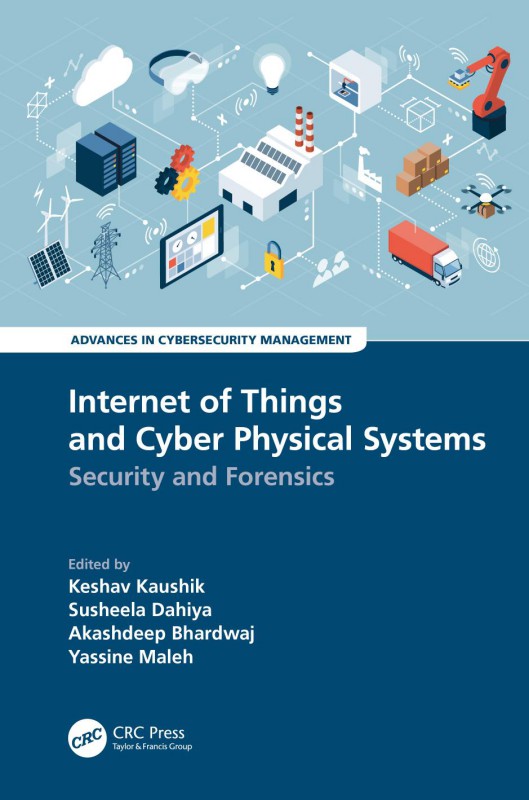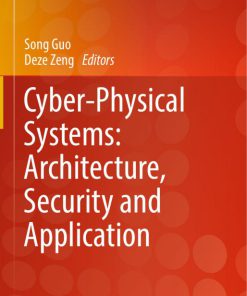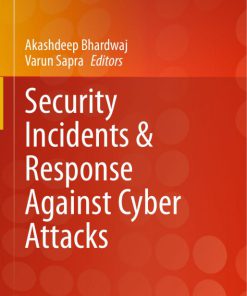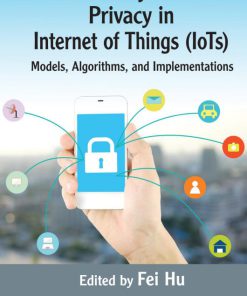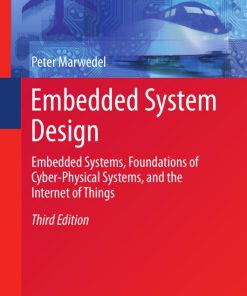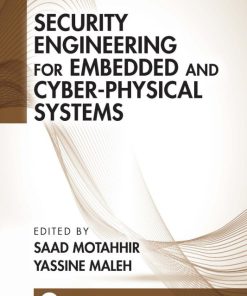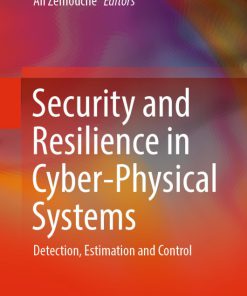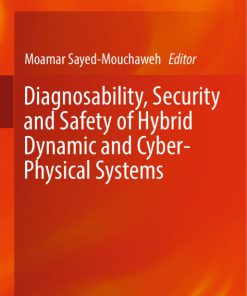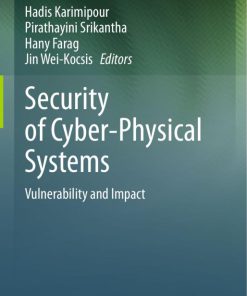Internet of Things and Cyber Physical Systems Security and Forensics 1st edition by Kaushik Keshav, Dahiya Susheela, Bhardwaj Akashdeep, Maleh Yassine 1000820130 9781000820133
$50.00 Original price was: $50.00.$25.00Current price is: $25.00.
Authors:Kaushik Keshav; Dahiya Susheela; Bhardwaj Akashdeep; Maleh Yassine; Saini Sameeka; Chauhan Abhilasha; Sapra Luxmi; Thakur Gesu; Garg Ankit; Singh Anuj Kumar; Parmar Priyank; Sheth Ravi; Vijarania Meenu; Gupta Swati; Agarwal Akshat; Akinsola J. E. T.; Abimbola R. O.; Adeagbo M. A.; Awoseyi A. A.; Onipede F. O.; Yusuf A. A.; Kumar Rajesh; Sharma Rewa; Singh Ankit Kumar; Kumar Vikas; Gupta Mukul; Gaur Shubhika; Sharma Vinita; Whig Pawan; Kouser Shama; Puruhit Kritika; Alam Naved; Velu Arun; Osonuga S. O.; Abdul-Yakeen S. O.; Olopade R. O.; Eyitayo A. O.; Badmus H. A. , Tags:Internet of Things and Cyber Physical Systems , Author sort:Keshav, Kaushik & Susheela, Dahiya & Akashdeep, Bhardwaj & Yassine, Maleh & Sameeka, Saini & Abhilasha, Chauhan & Luxmi, Sapra & Gesu, Thakur & Ankit, Garg & Kumar, Singh Anuj & Priyank, Parmar & Ravi, Sheth & Meenu, Vijarania & Swati, Gupta & Akshat, Agarwal & T., Akinsola J. E. & O., Abimbola R. & A., Adeagbo M. & A., Awoseyi A. & O., Onipede F. & A., Yusuf A. & Rajesh, Kumar & Rewa, Sharma & Kumar, Singh Ankit & Vikas, Kumar & Mukul, Gupta & Shubhika, Gaur & Vinita, Sharma & Pawan, Whig & Shama, Kouser & Kritika, Puruhit & Naved, Alam & Arun, Velu & O., Osonuga S. & O., Abdul-Yakeen S. & O., Olopade R. & O., Eyitayo A. & A., Badmus H. , Ids:DOI , Published:Published:Mar 2023 , Publisher:CRC Press , Comments:Comments:Internet of Things and Cyber Physical Systems
Internet of Things and Cyber Physical Systems Security and Forensics 1st edition by Kaushik Keshav, Dahiya Susheela, Bhardwaj Akashdeep, Maleh Yassine – Ebook PDF Instant Download/DeliveryISBN: 1000820130, 9781000820133
Full download Internet of Things and Cyber Physical Systems Security and Forensics 1st edition after payment.
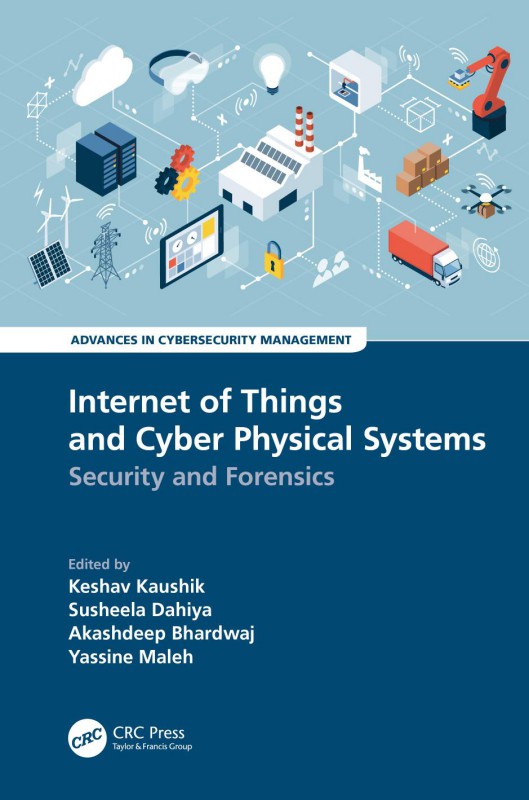
Product details:
ISBN-10 : 1000820130
ISBN-13 : 9781000820133
Author : Kaushik Keshav, Dahiya Susheela, Bhardwaj Akashdeep, Maleh Yassine
The quantity, diversity, and sophistication of Internet of Things (IoT) items are rapidly increasing, posing significant issues but also innovative solutions for forensic science. Such systems are becoming increasingly common in public locations, businesses, universities, residences, and other shared offices, producing enormous amounts of data at rapid speeds in a variety of forms. IoT devices can be used as suspects, digital witnesses, or instruments of crime and cyberattacks, posing new investigation problems, forensic issues, security threats, legal concerns, privacy concerns, and ethical dilemmas. A cyberattack on IoT devices might target the device itself or associated systems, particularly vital infrastructure. This book discusses the advancements in IoT and Cyber Physical Systems (CPS) forensics.
Internet of Things and Cyber Physical Systems Security and Forensics 1st Table of contents:
Chapter 1 Emerging Trends in Security, Cybercrime, and Digital Forensics in the Context of the Internet of Things
1.1 Introduction
1.2 Necessary Terminology
1.3 Digital and IoT Forensics
1.4 Challenges and Issues in IoT Forensics
1.5 IoT Forensics Approaches and Techniques
1.6 Conclusion
References
Chapter 2 Internet of Things (IoT): Security, Cybercrimes, and Digital Forensics
2.1 Introduction
2.2 IoT Technology
2.3 Layered Architecture of IoT
2.4 IoT Mechanisms and Their Building Blocks
2.5 Crucial Features of IoT
2.6 Different Communication Technologies of IoT
2.6.1 Wireless Fidelity (Wi-Fi)
2.7 Various Issues of IoT Networks
2.7.1 Threats to Security
2.7.2 Connectivity Issues
2.7.3 IoT Durability and Compatibility
2.7.4 Constraints in Computing
2.7.5 Big Data
2.8 Security Threats in IoT
2.8.1 Security Threats to the Perception Layer
2.8.2 Security Threats to the Network Layer
2.8.3 Security Threats to the Support Layer
2.8.4 Security Threats to the Application Layer
2.9 IoT Security Solutions
2.9.1 Security Solutions to the Perception Layer
2.9.2 Security Solutions to the Network Layer
2.9.3 Security Solutions to the Support Layer
2.9.4 Security Solutions to the Application Layer
2.10 Introduction to Digital Forensics
2.10.1 Process Involved in Digital Forensic Investigation
2.11 IoT Forensics
2.11.1 Related IoT Forensics Frameworks
2.11.2 Challenges of IoT Forensics
2.11.3 Adapting a Real-Time Approach for IoT Forensics
2.12 Conclusion and Future Directions
References
Chapter 3 Emerging Security Threats and Challenges in IoT
3.1 Introduction
3.2 The IoT Vision
3.2.1 IoT Architecture
3.2.2 IoT Application Domains
3.2.3 Supporting Wireless Communication Technologies
3.3 Security Threats and Challenges in the IoT
3.3.1 Intruder Models and Threats
3.3.2 Security and Privacy Challenges in IoTs
3.4 IoT Security Attacks and Their Mitigation Techniques Based on Their Layers
3.4.1 Physical Layer
3.4.2 Network Layer
3.4.3 Application Layer
3.5 Future Research Directions
3.6 Conclusion
References
Chapter 4 A Review on Security Frameworks and Protocols in the Internet of Things
4.1 IoT Introduction
4.2 IoT System Components
4.3 IoT Layered Architectures
4.4 Security Frameworks for the IoT System
4.4.1 IoT Security Domains
4.4.2 IoT Security and Privacy Threats
4.5 IoT Protocols at Different Layers
4.6 Conclusion and Future Work
References
Chapter 5 Application of Artificial Intelligence for DDoS Attack Detection and Prevention on Cyber Physical Systems Using Deep Learning
5.1 Introduction
5.1.1 Cyber Physical Systems
5.1.2 Cyber Physical Systems and Cyber Security
5.1.3 Emerging Technologies in Mitigating Cyber Physical System Attacks
5.2 Literature Review
5.2.1 Artificial Intelligence
5.2.2 Applications of Deep Learning in Cyber Physical Systems
5.3 Materials and Methods
5.3.1 Tools and Libraries for Deep Learning
5.4 Discussion of Results
5.4.1 Data Analytic and Visualization
5.4.2 Evaluation of Deep Learning Algorithms
5.4.3 Comparative Analysis of Deep Learning Algorithms
5.5 Conclusion
References
Chapter 6 Managing Trust in IoT Using Permissioned Blockchain
6.1 Introduction
6.2 Trust Management in the IoT: Introduction and Security Attacks
6.2.1 Trust-Related Security Attacks
6.3 Blockchain Technology and its Applications
6.3.1 Types of Blockchain
6.3.2 “Blockchain Basic Structure and Protocols”
6.3.3 Blockchain Applications of IoT
6.4 Hyperledger Fabric Architecture and Working Mechanisms
6.4.1 Hyperledger Fabric Architecture
6.4.2 Working Mechanism of Hyperledger Fabric
6.5 Integration of Blockchain and the IoT: Issues and Trusted Strategies
6.5.1 Integration Issues
6.5.2 Trusted Integration Strategies
6.6 IoT Trust Management Issues and their Solutions Using Hyperledger Fabric
6.6.1 Trusted Authentication Issue
6.6.2 Trusted Access Control Issue
6.6.3 Trusted Privacy Issue
6.6.4 Trusted Interoperability Issue
6.6.5 Trusted Integrity Issue
References
Chapter 7 Cyber Physical System Security
7.1 Introduction
7.1.1 3 C Concept of Cyber Physical Systems
7.2 Features of Cyber Physical Systems
7.3 Characteristics of Cyber Physical Systems
7.3.1 Agriculture
7.3.2 Transportation
7.3.3 Automation
7.3.4 Healthcare
7.3.5 Ocean Monitoring
7.3.6 Smart Grid
7.4 Challenges Faced by Cyber Physical Systems
7.4.1 Data Privacy
7.4.2 Data Management
7.4.3 Reliability
7.4.4 Real-Time Challenges
7.4.5 Eavesdropping
7.4.6 Man in the Middle Attack
7.4.7 Denial of Service Attack
7.4.8 Integrity
7.4.9 Robustness
7.4.10 Untrained Employees
7.5 Real-Life Instances
7.6 Risk Mitigation Techniques
7.7 Previous Solutions
7.8 Methodology
7.9 Results
7.10 Conclusion
References
Chapter 8 Intrusion Detection Systems Apropos of the Internet of Things (IoT)
8.1 Introduction
8.2 IoT Paradigm
8.2.1 Definitions
8.2.2 Architecture
8.2.3 Cloud Computing for the IoT
8.3 Smart Environments using the IoT
8.3.1 Definitions
8.3.2 Smart Surroundings Enabled IoT
8.4 Security and Privacy Issues
8.4.1 Security Issues in IoT layers
8.4.2 Challenges
8.5 Intrusion Detection Systems
8.5.1 Overview
8.5.2 Methods and Techniques
8.6 IDS for the IoT
8.6.1 Methods and Techniques
8.6.2 Intrusion Detection Based on Anomalies
8.6.3 Intrusion Detection Based on Specifications
8.6.4 IDSs With IoT Systems
8.7 Conclusion and Future Discussions
References
Chapter 9 Intrusion Detection for the Internet of Things
9.1 Introduction
9.1.1 IoT Architecture
9.2 Literature
9.3 IDS Classification (Figure 9.2)
9.3.1 Signature-based IDS
9.3.2 Anomaly-based IDS
9.3.3 Network-based IDS
9.3.4 Distributed IDS (DIDS)
9.3.5 Host-based IDS (HIDS)
9.4 Techniques of Intrusion Detection Systems (Figure 9.3)
9.4.1 Supervised Learning in an Intrusion Detection System
9.4.2 Unsupervised Learning in an IDS
9.4.3 Reinforcement Learning
9.4.4 Deep Learning
9.5 Security Threats to the Internet of Things (IoT)
9.5.1 Physical Layer
9.5.2 Software/Application Layer
9.5.3 Network Layer
9.6 IoT Security Issues and Challenges
9.6.1 Challenges
9.7 Importance of Intrusion Detection Systems in Cybersecurity
9.8 Future Work and Conclusion
References
Chapter 10 Cybercrimes and Digital Forensics in Internet of Things
10.1 Introduction
10.2 Internet of Things
10.2.1 Basic Characteristics of the IoT
10.2.2 Building Blocks of the IoT
10.2.3 Technologies Used for IoT Communication
10.2.4 IoT Protocols
10.2.5 IoT Layers
10.3 Cybercrimes
10.3.1 Role of the IoT in Assisting Cybercrimes
10.4 Digital Forensics
10.4.1 Digital Forensics Process Model
10.5 IoT Forensics Process
10.6 The Internet of Things’ Role in Digital Forensics
10.6.1 Role of the IoT in Assisting Digital Forensics
10.6.2 Role of the IoT in Assisting Cybercrimes
10.7 Challenges of IoT Forensics
10.7.1 Diversity
10.7.2 IoT Devices and Data Location and Identification
10.7.3 Inadequate Standardization
10.7.4 IoT Evidence Lifespan
10.7.5 Currently Available Forensic Tools
10.8 Conclusion
References
Chapter 11 Security and Privacy for IoT-based Smart Cities
11.1 Introduction
11.2 Overview of a Smart City
11.3 Architecture on the Outside
11.3.1 Sensor Placement
11.3.2 Infrastructure
11.3.3 Internal Structure
11.4 Objective of Smart Cities
11.4.1 Smart Governance
11.4.2 Transportation
11.4.3 Environment
11.4.4 Utilities
11.4.5 Services
11.5 Characteristics
11.5.1 Heterogeneity
11.5.2 Resources
11.5.3 Mobility
11.5.4 Scalability
11.5.5 Participation of Users
11.6 Privacy and Security
11.6.1 Botnet Activities in the Internet of Things (IoT)
11.6.2 Dangers of Self-Driving Cars
11.6.3 Virtual Reality’s Privacy Issues
11.6.4 Artificial Intelligence Threats in Smart Cities
11.7 Requirements for Security
11.7.1 Confidentiality and Authentication
11.7.2 Integrity and Availability
11.7.3 Detection and Prediction of Lightweight Intrusion
11.7.4 Protection of Privacy
11.7.5 Security and Privacy
11.7.6 Cryptography
11.7.7 Blockchain
11.7.8 Biometrics
11.7.9 Data Mining
11.7.10 Ontology
11.8 Future Prospects
11.8.1 IoT-based Network Security
11.8.2 Fog-based Systems
11.8.3 Protection Methods that are User-Centric and Personalized
11.8.4 Complementary Theory
11.9 Conclusion
References
Chapter 12 Network Vulnerability Analysis for Internet of Things (IoT)-based Cyber Physical Systems (CPS) Using Digital Forensics
12.1 Cyber Physical System
12.1.1 Areas of Application of Cyber Physical Systems in Different Domains
12.1.2 Digital Forensics
12.1.3 Areas of Application of Cyber Forensics
12.1.4 Network Forensics
12.1.5 IoT and CPS Vulnerabilities
12.1.6 Attacks on the IoT and CPS
12.1.7 Network Vulnerability on IoT-Based CPSs
12.2 Literature Review
12.2.1 Forensic Analysis
12.2.2 Related Work
12.3 Materials and Methods
12.3.1 Forensic Analysis Framework
12.3.2 Wireshark
12.3.3 TCPDump
12.4 Results and Discussion of Findings
12.4.1 Digital Forensic Analysis Using Wireshark
12.4.2 Digital Forensic Analysis Using TCPDump
12.5 Comparison of Wireshark and TCPDump Forensic Analysis
12.6 Conclusions and Recommendations
People also search for Internet of Things and Cyber Physical Systems Security and Forensics 1st:
internet of things and cyber physical systems abbreviation
internet of things and cyber physical systems journal abbreviation
internet of things and cyber-physical systems (icps)
internet of things and cyber physical systems letpub
internet of things and cyber physical systems security and forensics

